1945–1960 in Western fashion

Fashion in the years following World War II is characterized by the resurgence of haute couture after the austerity of the war years. Square shoulders and short skirts were replaced by the soft femininity of Christian Dior's "New Look" silhouette, with its sweeping longer skirts, fitted waist, and rounded shoulders, which in turn gave way to an unfitted, structural look in the later 1950s.
Innovations in textile technology following the war resulted in new fabrics such as spandex, volleyball shorts and easy-care fabric finishes that fitted the suburban lifestyle of the 1950s with its emphasis on casual sportswear for both men and women. For the first time, teenagers became a force in fashion.
General trends
- The return of fashion
By 1947, the Paris fashion houses had reopened, and once again Paris resumed its position as the arbiter of high fashion. The "orderly, rhythmic evolution of fashion change"[1] had been disrupted by the war, and a new direction was long overdue. The padded shoulder, tubular, boxy line, and short skirt (that had been around since before the war and was identified with uniforms) was gone.[2] A succession of style trends led by Christian Dior and Cristóbal Balenciaga defined the changing silhouette of women's clothes through the 1950s. Television joined fashion magazines and movies in disseminating clothing styles.[3][4] The new silhouette had narrow shoulders, a cinched waist, bust emphasis, and longer skirts, often with wider hems.[2]
- The beginnings of Eastern fashion

During the early 1950s, designers in the decolonised Third World sought to create an identity distinct from European fashion. Urban professionals in Asia and the Middle East, for example, might wear Western style suits with indigenous headgear such as the Astrakhan, fez or keffiyeh. In India, the traditional Sherwani was adapted into the Nehru collar business suit,[5] while women frequently wore sarees in the workplace. Meanwhile, the Red Chinese developed the unisex Mao Suit in green, blue and grey to promote socialist values of equality.[6] Due to their minimalist, modern design, both types of suit would later be adopted by mod and British invasion trendsetters during the 1960s and 70s, especially The Beatles and The Monkees.[7][8]
- Casual clothing and teenage style
One result of the Post-World War II economic expansion was a flood of synthetic fabrics and easy-care processes. "Drip-dry" nylon, orlon and dacron, which could retain heat-set pleats after washing, became immensely popular.[9] Acrylic, polyester, triacetate and spandex were all introduced in the 1950s.[10] During the 1940s nylon stockings were an incredibly popular product as they were a lightweight alternative to silk and wool stockings. For the duration of WW2 the Du Pont company produced nylon exclusively for the war effort. At the end of 1945 the demand for nylon stockings was so great that Nylon riots ensued at stores selling the products. [11][12][13]

Social changes went hand-in-hand with new economic realities, and one result was that many young people who would have become wage-earners early in their teens before the war now remained at home and dependent upon their parents through high school and beyond, establishing the notion of the teenage years as a separate stage of development.[10] Teens and college co-eds adopted skirts and sweaters as a virtual uniform, and the American fashion industry began to target teenagers as a specialized market segment in the 1940s.[14]
In the United Kingdom, the Teddy boys of the post-war period created the "first truly independent fashions for young people",[10] favouring an exaggerated version of the Edwardian-flavoured British fashion with skinny ties and narrow, tight trousers worn short enough to show off garish socks.[10] In North America, greasers had a similar social position. Previously, teenagers dressed similarly to their parents, but now a rebellious and different youth style was being developed.
Young adults returning to college under the G.I. Bill adopted an unpretentious, functional wardrobe, and continued to wear blue jeans with shirts and pullovers for general informal wear after leaving school.[15] Jack Kerouac introduced the phrase "Beat Generation" in 1948, generalizing from his social circle to characterize the underground, anti-conformist youth gathering in New York at that time. The term "beatnik" was coined by Herb Caen of the San Francisco Chronicle in 1958,[16] and the stereotypical "beat" look of sunglasses, berets, black turtlenecks, and unadorned dark clothing provided another fashion alternative for youths of both sexes, encouraged by the marketing specialists of Madison Avenue.
Womenswear
- The New Look



On February 12, 1947, Christian Dior launched the first collection of the House of Dior. The new collection went down in fashion history as the "New Look". The signature shape was characterized by a below-mid-calf length, full-skirt, pointed bust, small waist, and rounded shoulder line.[17] Resisted at first, especially in America, where fashion magazines showed padded shoulders until 1950,[1] the radical new silhouette soon became immensely popular, influencing fashion and other designers for many years to come. The "softness" of the New Look was deceptive; the curved jacket peplum shaped over a high, rounded, curved shoulders, and full skirt of Dior's clothes relied on an inner construction of new interlining materials to shape the silhouette.[18][19] This silhouette has drastically changed from its previous more masculine, stiff, triangular shape to a much more feminine form.[20]
Throughout the post-war period, a tailored, feminine look was prized and accessories such as gloves and pearls were popular. Tailored suits had fitted jackets with peplums, usually worn with a long, narrow pencil skirt. Day dresses had fitted bodices and full skirts, with jewel or low-cut necklines or Peter Pan collars. Shirtdresses, with a shirt-like bodice, were popular, as were halter-top sundresses. Skirts were narrow or very full, held out with petticoats; poodle skirts were a brief fad. Ball gowns (full-skirted gown for white tie occasions) were longer than ankle-length dresses (called "ballerina length"), reaching the floor and worn to balls (as they are today). Cocktail dresses, "smarter than a day dress but not as formal as a dinner or evening dress"[21] were worn for early-evening parties. Short shrugs and bolero jackets, often made to match low-cut dresses, were worn.[22][23]
- Clothes for the space age
From the mid-1950s, a new unfitted style of clothing appeared as an alternative to the tight waist and full skirt associated with the New Look. Vogue Magazine called the knitted chemise the "T-Shirt dress." Paris designers began to transform this popular fashion into haute couture.[24] Spanish designer Balenciaga had shown unfitted suits in Paris as early as 1951 and unfitted dresses from 1954. In 1958, Yves Saint Laurent, Dior's protégé and successor, debuted the "Trapeze Line," adding novel dimension to the chemise dress. These dresses featured a shaped bodice with sloping shoulders and a high waist, but the signature shape resulted from a flaring bodice, creating a waistless line from bodice to knees.[25] These styles only slowly gained acceptance by the wider public.[26][27] Coco Chanel made a comeback in 1954 and an important look of the latter 1950s was the Chanel suit, with a braid-trimmed cardigan-style jacket and A-line skirt. By 1957, most suits featured lightly fitted jackets reaching just below the waist and shorter, narrower skirts. Balenciaga's clothes featured few seams and plain necklines, and following his lead chemise dresses without waist seams, either straight and unfitted or in a princess style with a slight A-line, became popular. The sleeveless, princess-line dress was called a skimmer.[26][28] A more fitted version was called a sheath dress.
A popular style of brassiere for women during the 1950s was the "bullet bra", where cups were pointed in a conical shape.[29][30][31] This brassiere design was popularized by actresses like Patti Page, Marilyn Monroe, and Lana Turner, who was nicknamed the "Sweater Girl".[32]
- Sportswear
New York had become an American design center during the war, and remained so, especially for sportswear, in the post-war period.[33] Women who had worn trousers on war service refused to abandon these practical garments which suited the informal aspects of the post-war lifestyle. Casual sportswear was an increasingly large component of women's wardrobes. Casual skirts were narrow or very full. In the 1950s, pants became very narrow, and were worn ankle-length. Pants cropped to mid-calf were houseboy pants; shorter pants, to below the knee, were called pedal-pushers. Shorts were very short in the early '50s, and mid-thigh length Bermuda shorts appeared around 1954 and remained fashionable through the remainder of the decade. Loose printed or knit tops were fashionable with pants or shorts. They also wore bikinis to sport training.[34]
Swimsuits were one- or two-piece; some had loose bottoms like shorts with short skirts. Bikinis appeared in Europe but were not worn in America in the 1950s.[34]
- Hats and hairstyles
Hair was worn short and curled with the New Look, and hats were essential for all but the most casual occasions.[22] Wide-brimmed saucer hats were shown with the earliest New Look suits, but smaller hats soon predominated. Very short cropped hairstyles were fashionable in the early '50s. By mid-decade hats were worn less frequently, especially as fuller hairstyles like the short, curly poodle cut and later bouffant and beehive became fashionable.[26][35] "Beat" girls wore their hair long and straight, and teenagers adopted the ponytail, short or long.
- Maternity wear
In the 1950s, Lucille Ball was the first woman to show her pregnancy on TV.[36] [37] The television show I Love Lucy brought new attention to maternity wear. Most of the maternity dresses were two pieces with loose tops and narrow skirts. Stretch panels accommodated for the woman's growing figure. The baby boom of the 1940s to the 1950s also caused focus on maternity wear. Even international designers such as Givenchy and Norman Hartnell created maternity wear clothing lines. Despite the new emphasis on maternity wear in the 1950s maternity wear fashions were still being photographed on non-pregnant women for advertisements.[38]
On September 29, 1959, the maternity panty was patented which provided expansion in the vertical direction of the abdomen. The front panel of this maternity undergarment was composed of a high degree of elasticity so in extreme stretched conditions, the woman could still feel comfortable.[39]
- Style gallery 1945–1954
-

1948
-

1952
-

1952
-

1953
-

1953
-

1953
-

1953
-
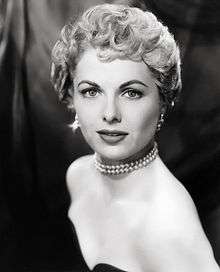
1954
- Actress Probable unidentified young actress in Cannes, 1948
- Wide-legged trousers with cuffs (turn-ups) are shown with a short-sleeved, fitted sweater, Germany, 1952.
- Two-piece swimsuit, 1952.
- Actress Audrey Hepburn, 1953.
- Actress Lucille Ball in cropped houseboy pants at a press conference, Los Angeles, 1953.
- Fashion illustration of a "corselette", showing the pointed bust and curvy hipline of 1953.
- Actresses Marilyn Monroe and Jane Russell wear halter-top summer dresses, Hollywood, 1953.
- Actress Martha Hyer's hair is worn in a short and curly poodle cut in this publicity photo for Sabrina, 1954.
- Style gallery 1954–1960
-

1954
-
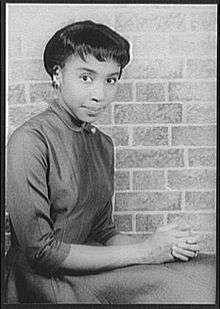
1955
-
1955
-

c. 1957
-

1958
-

1958
-

1959
- First Lady Mamie Eisenhower in bright blue day dress, 1954.
- Actress Diahann Carroll wears a full-skirted dress with a small Peter Pan collar, 1955.
- Singer Patti Page wearing a "bullet bra" brassiere design in 1955.
- Actress Marilyn Monroe in The Prince and the Showgirl wears a fitted sheath dress with a sweetheart neckline, 1957.
- Short hair style, 1958
- Summer dresses of 1958 are sleeveless with high, wide "boat" necklines, Dresden.
- Singer Anita O'Day performing in 1958 wearing a tight-fitting sheath dress.
- Newspaper photo of "Miss Beatnik" contestants in Venice, California, 1959.
Menswear
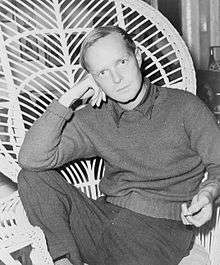

- Suits
Immediately after the war, men's suits were broad-shouldered and often double-breasted. As wartime restrictions on fabric eased, trousers became fuller, and were usually styled with cuffs (turn-ups). In America, Esquire introduced the "Bold Look", with wide shoulders, broad lapels, and an emphasis on bold, coordinated accessories.[40][41] In Britain, clothing rationing remained in place until 1949. Demobilised soldiers were provided with a suit by the government, usually in blue or grey chalkstripes. Savile Row, the traditional home of bespoke or custom tailoring, had been heavily damaged in the Blitz and was slow to recover.[40] In 1950, Harper's Bazaar proclaimed the "Return of the Beau". Savile Row introduced the "New Edwardian Look", featuring a slightly flared jacket, natural shoulders, and an overall narrower cut, worn with a curly-brimmed bowler hat and a long slender overcoat with velvet collar and cuffs.[41][42][43] This was the style commandeered by the Teddy Boys, who added bright socks and a bootlace necktie, achieving a "dizzy combination of Edwardian dandy and American gangster."[42] The horrified tailors of Savile Row dropped the overtly Edwardian touches, but the style of business suits continued to move away from the broad English drape cut, and single-breasted two-piece suits with narrower lines and less padding in the shoulders became fashionable everywhere. Dark charcoal gray was the usual color, and the era of the gray flannel suit was born. By the later 1950s, a new Continental style of suit appeared from the fashion houses of Italy, with sharper shoulders, lighter fabrics, shorter, fitted jackets and narrower lapels.[41][44]
- Sports and leisurewear
Sport coats generally followed the lines of suit coats. Tartan plaids were fashionable in the early 1950s, and later plaids and checks of all types were worn, as were corduroy jackets with leather buttons and car coats. Khaki-colored pants, called chinos, were worn for casual occasions. Bermuda shorts, often in madras plaid, appeared in mid-decade and were worn with knee socks. Hawaiian shirts, worn untucked from suspenders, also became widely popular during this era.This summer fashion of the Hawaiian or Carioca shirt became particularly popular in America, with even President Truman being photographed wearing a marine flora shirt.[45] Knit shirts and sweaters of various kinds were popular throughout the period.[41] Some young men wore tight trousers or jeans, leather jackets, and white tee shirts.
- Hats and hairstyles
Men's hair fashion favoured the wet look, achieved by the use of products such as Brylcreem. Young men often grew their hair out and, with pomade or other hair treatments, coiffed their hair into pompadours.
- Accessories
Browline eyeglasses were commonly worn by men during the 1950s and early 1960s.[46][47]
- Style gallery 1945–1949
-

Frank Sinatra wearing the pleated trousers fashionable in 1947.
-

Taking delivery of a new car, 1947.
-

Single-breasted summer suit with cuffed trousers and matching hat, Hot Springs National Park, 1948.
-

Men's and boys' casual sports clothes for 1948.
-

Insurance salesmen wear suits, hats, and patterned ties, Minneapolis, 1949.
- Style gallery 1950–1960
-

Double-breasted suit, New Orleans, early 1950s
-

Formal wear remained essentially unchanged from previous periods, but was worn less frequently. The Duke of Edinburgh in formal morning dress, 1951
-
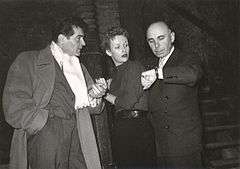
Emil-Edwin Reinert, Joan Camden, and Francis Lederer in a production of Stolen Identity, Vienna, 1952. Lederer (left) wears a broad-shouldered overcoat and scarf
-

Walt Disney and Wernher von Braun in single-breasted two piece suits, 1954.
-
Browline glasses for men.
-

Belgian singers Jacques Brel and Bobbejaan Schoepen wear modified pompadour hairstyles, suits with sharply peaked lapels, and patterned ties, 1955.
-
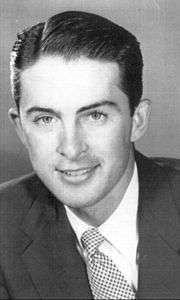
Actor Chet Allen wears "wet look" hair parted on the side, 1957.
-

Jack Benny, former U.S. President Harry Truman, and Hans Schweiger in overcoats, 1958.
-
.jpg)
"Continental" style suits of 1959: Cary Grant in North by Northwest.
-
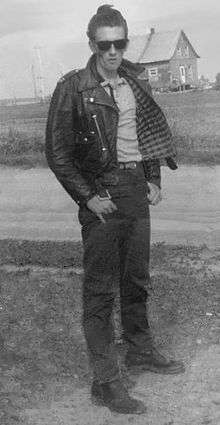
Canadian greaser or rocker wearing Schott Perfecto and Levi Strauss jeans, 1960
Youth fashion
Hepcats
- During and after the war, oversized zoot suits were worn by rebellious teenagers, hep cats, and gang members, especially African-Americans, Italian-Americans, Cholos a.k.a pachucos, and Chicanos.[48] Suit coats were long and double breasted, and pants were high waisted and very baggy. The look was completed with a large pocketwatch chain, black and white spectator shoes, a wide brimmed fedora, and a brightly colored silk kipper tie.[49]
Greasers
- From the late 1940s until the mid 1960s, many Irish-American and Italian-American teenagers were involved with hot rodding, custom cars, and chopper bikes. American greasers, Japanese Bosozoku, Swedish Raggare and Aussie Bodgies based their look on the clothing worn by mechanics and fighter pilots, including a black Schott Perfecto leather jacket, black or white T shirt, and blue Levi's 511 drainpipe jeans worn with Engineer boots, Converse All Stars, and cowboy boots.[50][51] The British equivalent, known as the Ton-up Boys, dressed similarly but rode lightweight cafe racer Triumph and BSA bikes.[52] Some girls wore jeans and leather jackets like the men, but most wore more typical college attire such as poodle skirts, petticoats, cardigan sweaters, and saddle shoes with bobby socks.
Teds
- During the early 1950s, Britain's own rockabilly subculture appropriated the then fashionable Edwardian revivalist fashion due to its resemblence to the clothing worn by Old West gamblers and the zoot suits seen in gangster films.[53] A typical Teddy Boy outfit included a red or sky blue drape jacket with velvet shawl collar, drainpipe trousers, brocade waistcoat, bolo tie, and winklepickers or brothel creepers.[54] Teddy Girls, known as Judies, often wore long circle skirts, capri pants, espadrilles, cameo brooches and coolie hats.[55]
Beatniks
- In the late 1950s, the precursor to the late 1960s hippies and 2010s hipster subculture emerged in Bohemian parts of London, Paris and the urban US. Black roll neck sweaters, sandals, sunglasses, striped shirts, horn rimmed glasses, and berets were popular among Beatniks of both sexes, and men often wore beards.[56] The Russian equivalent of the Beatnik, known as Stilyagi, wore thick soled shoes, brightly colored socks, and exaggerated American style clothing in imitation of Western film actors and modern jazz musicians.[57]
Children's wear
Due to the baby boom, there was a high demand for clothing for children. Children's clothing began to be made to a higher quality, and some even adopted trends popular with teenagers; many boys started wearing jeans to Elementary school. Many girls' and young women's dresses were styled after those of the older women.
-

Child's dress, 1947
-

Girl's dress, 1953
See also
| Wikimedia Commons has media related to 1940s fashion. |
| Wikimedia Commons has media related to 1950s fashion. |
- Teddy Boy
- Ducktail
- Dior
- Cristóbal Balenciaga
- Hubert de Givenchy
- Jean Dessès
- Guy Laroche
- Roger Vivier
- Norman Hartnell
- Charles James (designer)
- Hardy Amies
- Audrey Hepburn
- Grace Kelly
- Marilyn Monroe
- Babe Paley
- Elvis Presley
Notes
- 1 2 Brockman (1965), p. 54
- 1 2 Russell, Douglas (1983). Costume History and Style. Englewood Cliffs, NJ: Prentice-Hall, Inc. pp. 453–454. ISBN 0-13-181214-9.
- ↑ Brockman (1965), pp. 54–55
- ↑ Tortora & Eubank (1994), p. 414.
- ↑ Historic costume
- ↑ Mao suit and Nehru jacket
- ↑ 1960s fashion
- ↑ British invasion
- ↑ Brockman (1965), p. 75.
- 1 2 3 4 Tortora & Eubank (1994), p. 413.
- ↑ "Stocking Series, Part 1: Wartime Rationing and Nylon Riots". Smithsonian Magazine. Retrieved December 11, 2013.
- ↑ "How Nylon Changed the World : 50 Years Ago Today, It Reshaped the Way We Live--and Think". LA Times. October 27, 1988. Retrieved December 11, 2013.
- ↑ Handley, Susannah (1999). Nylon: The Story of a Fashion Revolution. Johns Hopkins Univ. Press. p. 48. ISBN 978-0756771720.
- ↑ Tortora & Eubank (1994) p. 406
- ↑ Brockman (1965), p. 76.
- ↑ Caen, Herb. San Francisco Chronicle, April 2, 1958.
- ↑ Tortora & Eubank (2005), pp. 415–420.
- ↑ Brockman (1965), p. 53.
- ↑ See "New Look" jacket by Dior, "New Look" suit by Hardie Amies, V&A Museum.
- ↑ Bigelow, Marybelle S. (1979). Fashion in History: Western Dress, Prehistoric to Present. Minneapolis, Minnesota: Burgess Publishing Company. p. 309.
- ↑ Cumming (2010), p. 51
- 1 2 Tortora & Eubank (2005), pp. 420–426.
- ↑ See Cocktail dress by Dior with matching shrug or bolero, V&A Museum
- ↑ Wilcox, R. Turner (1958). The Mode in Costume. New York: Charles Scribner's Sons. p. 417.
- ↑ Wilcox, R. Turner (1958). The Mode in Costume. New York: Charles Scribner's Sons. p. 417.
- 1 2 3 Tortora & Eubank (1994), p. 427
- ↑ See Balenciaga suit, 1954/55, V&A Museum
- ↑ Brockman (1965), pp. 39, 50
- ↑ "The Bra". Vogue.com "Voguepedia". Retrieved 11 December 2013.
- ↑ "Pointy bras make a comeback as sales of 'Marilyn Monroe' underwear enjoy an uplift". Huffington Post. 4 November 2009. Retrieved 11 December 2013.
- ↑ "Conical bras are flying off the shelves...". Daily Mail. 5 November 2009. Retrieved 11 December 2013.
- ↑ "Lingerie from History We Would (Probably) Never Wear Again". 2 February 2012. Retrieved 19 March 2013.
- ↑ Tortora & Eubank (1994), pp. 415–18
- 1 2 Tortora & Eubank (1994), pp. 421–23
- ↑ Cumming (2010), p. 163
- ↑ Tortora & Eubank (1994), p. 414
- ↑ Scholarly Article. "Celebrate Women's History Month" Rochester Democrat and Chronicle. copyright 2008.
- ↑ Tortora & Eubank (2005), pp. 432, 439
- ↑ D. L. Rosenburg. September 29, 1959. United States Patent Office. Maternity Panty.
- 1 2 Walker (1988), p. 106
- 1 2 3 4 Tortora & Eubank (1994), pp. 432–33
- 1 2 Walker (1988), pp. 108–109
- ↑ See "New Edwardian"-style suit, at the V&A.
- ↑ Walker (1988), p. 116
- ↑ Chenoune, Farid (4 October 1993). A History of Men's Fashion. Paris: Flammarion. pp. 223–225. ISBN 978-2-08013-536-0.
- ↑ "Looking Back": an illustrated history of the American Ophthalmic Industry, by the Optical Laboratories Association
- ↑ Fassel, Preston. "Hindsight is 20/20: The Browline". The Optician's Handbook. Retrieved 2013-06-10.
- ↑ The zoot suit
- ↑ V and A museum
- ↑ Rockers vs Mods
- ↑ Tokyo rockabilly gangs
- ↑ Cafe racers
- ↑ Edwardian Teddy Boy
- ↑ Teddy Boys
- ↑ The forgotten 1950s girl gang
- ↑ Beatnik generation
- ↑ Stylehunters of Soviet Russia
References
- Brockman, Helen. The Theory of Fashion Design, New York: John Wiley and Sons, 1965, ISBN 0-471-10586-4,
- Cumming, Valerie, C. W. Cunnington and P. E. Cunnington. The Dictionary of Fashion History, Berg, 2010, ISBN 978-1-84788-533-3
- Samek, Susan M. "Uniformly Feminine: the "Working Chic" of Mainbocher." Dress 20 (1993): p. 33–41.
- Tortora, Phyllis G. and Keith Eubank. Survey of Historic Costume. 2nd Edition, 1994. Fairchild Publications. ISBN 1-56367-003-8
- Tortora, Phyllis G. and Keith Eubank. Survey of Historic Costume. 4th Edition, 2005. Fairchild Publications.
- Walker, Richard: The Savile Row Story, Prion, 1988, ISBN 1-85375-000-X
External links
- Patent to the Maternity Panty
- "The Golden Age of Couture: Paris and London 1947–57, museum exhibition". Victoria and Albert Museum. Archived from the original on 10 May 2008. Retrieved 7 May 2008.
- Dresses by Christian Dior, Indianapolis Museum of Art
- Children's clothing from the 1950s
- Examples of French fashion illustration
- "1940s – 20th Century Fashion Drawing and Illustration". Fashion, Jewellery & Accessories. Victoria and Albert Museum. Retrieved 2011-04-03.
- "1950s – 20th Century Fashion Drawing and Illustration". Fashion, Jewellery & Accessories. Victoria and Albert Museum. Retrieved 2011-04-03.
- Vintage Photos - art, life and fashion in the 20th Century.
- Madame Grès, an exhibition catalog from The Metropolitan Museum of Art (fully available online as PDF), which contains a good deal of material on fashion from this period
| ||||||||||||||||||||||||||||||||||||||||||||||||||||||||||||||||||||||||
